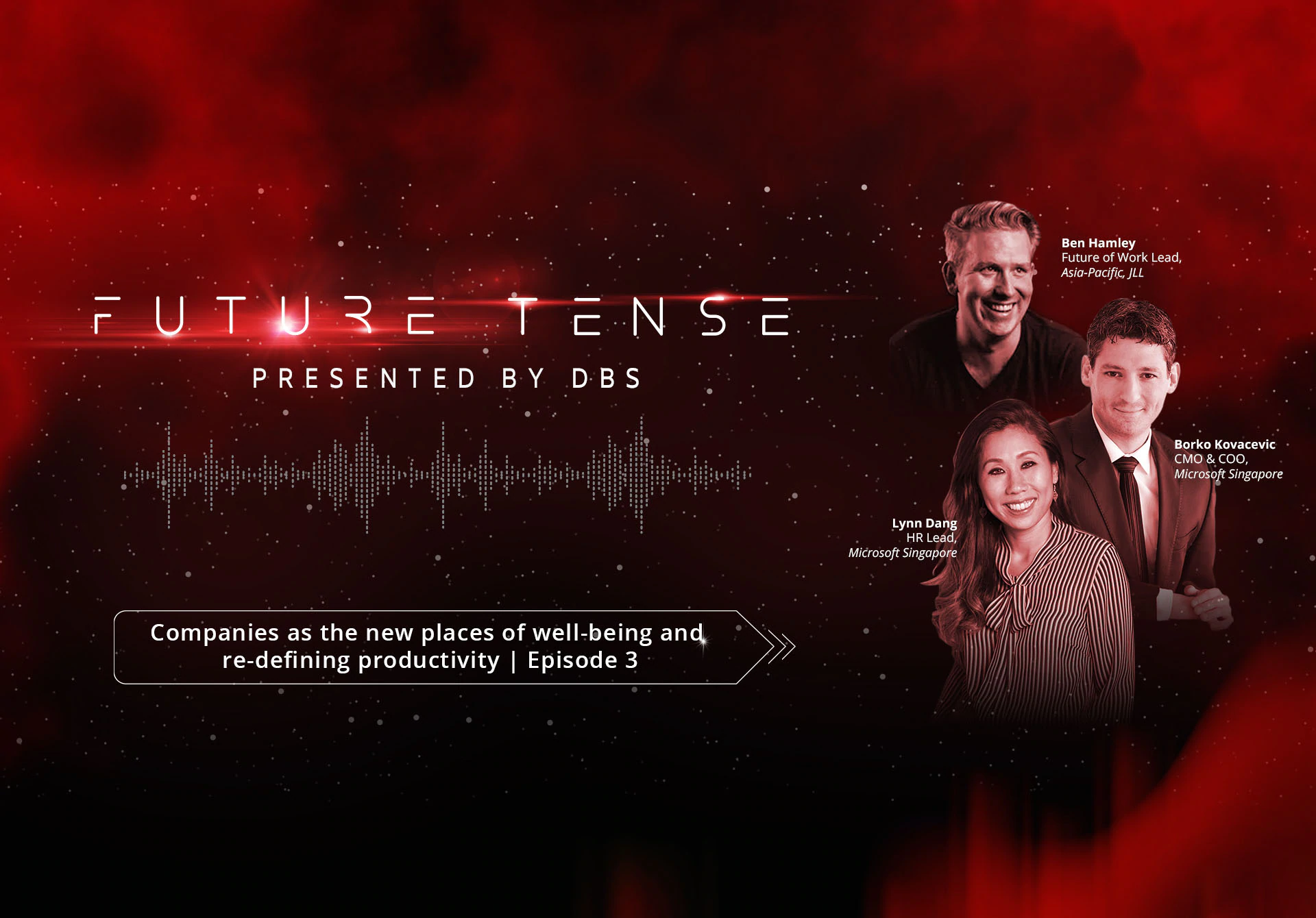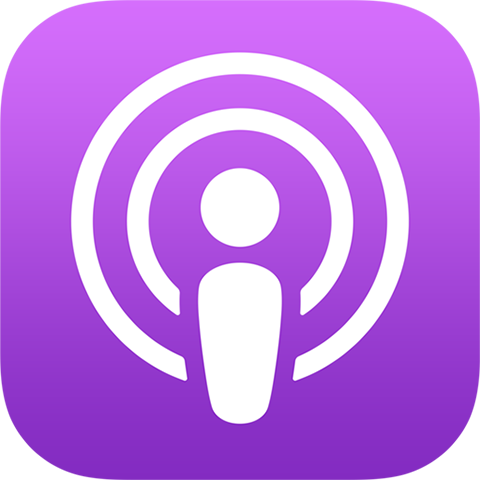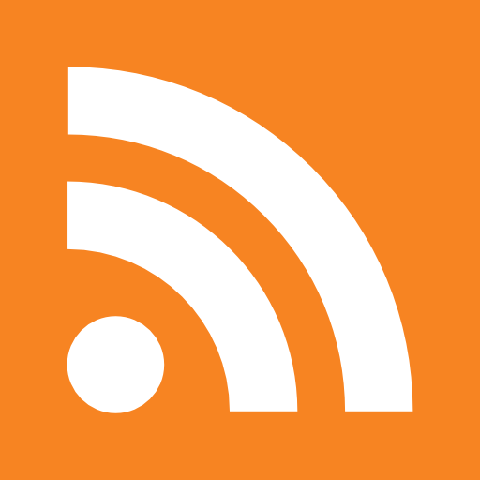Listen to this story
00:00
18:00
Subscribe to our podcast:
In brief:
-
Companies are putting much more effort in well-being, and making sure people really find that sense of purpose when at work.
-
Longer work hours at home have paved the way for discussions on mental health in Asia’s workplaces.
-
The rise in remote work has revealed a divide between the haves and have-nots.
-
The right kind of infrastructure, such as ubiquitous connectivity and tools for remote work, is needed to support work from anywhere.
-
Companies need to balance between enabling security, and empowering employees to work remotely.
-
Companies need to re-examine how they measure productivity and high performers.
Welcome to Future Tense, by DBS. We look at what's to come for Asia and the world as technology evolves at an accelerating pace. We get you comfortable with the future as business leaders tackle big questions about sustainability, innovation, fintech and more.
In our last two episodes on the future of work, we looked at how culture, and innovation at the workplace will change with a more democratised and distributed workforce.
And with those changes, how then can we expect the dynamics between a company and its employees to evolve? How will job roles adapt to new ways of working?
Ben Hamley, JLL's Asia-Pacific Lead for the Future of Work, pointed to one big challenge arising from the rise in remote work.
Ben: The biggest downside of everything has been that it's revealed a bit of a divide in the haves and have-nots. It's very easy to work remotely if you're a knowledge worker. You have an iPad, a good laptop, reliable Wi-Fi and a space in your house where you can get some silence from the kids. But if you don't, and you've got a lot of people living in your house and everyone's at school at the same time, then it can be very hard, and for some very, very difficult to still be productive.
How can companies improve the employee experience in the future workplace, wherever that may be?
The implications of greater work flexibility and rise in remote work, call for a rethink in how companies are engaging with employees, how performance is measured, the technological infrastructure that needs to be in place.
Our host Carolyn Camoens dives into these issues with our guests from Microsoft Singapore – Borko Kovacevic, CMO and COO, and Lynn Dang, HR Lead.
Companies to become “places of well-being”
Borko: That's, again, one of the things that's been top of mind for many companies. Before Covid, there was fierce competition for talent. They were trying to impress the talent with office space, with the physical appearance, with what kind of benefits they bring in there – free food, pantry – different kind of benefits they offer to talent.
And while they were really commendable attempts across the world, I think the corporates have been trying to appeal to the younger generations and older generations as well, as the best place to work, there’s one fundamental shift that needs to happen and started to happen, especially with Covid. A trend that will happen in the next couple of years is, companies need to become places of well-being for employees.
The typical way that you experience work in the last decade was that you go to the office, you give your best, you get stressed out, you spend up to 10 hours, even longer hours at work. You come home, you're completely depleted, you're exhausted, and you leave nothing for your family or loved ones. And then tomorrow they wake up again and the day starts again.
So effectively, workplace and work is a place where you go to get stressed, then you burnout.
And this trend has started to change by companies putting much more effort in well-being, not just physical well-being, but mental emotional well-being and making sure that people really find that sense of purpose when they're at work.
And there needs to be a collective and individual sense of purpose which will help employees experience their work in a much more meaningful way.
If that's the case, then they will go to work to get better. They will go to work to get energised, to feel that emotional attachment and that surge of energy and motivation that will lead them through the day.
And when they could go back home, even if they're working from home, when they're working from anywhere, it doesn't matter. But their energy will be there because they need to spend that and invest that energy in things that matter, to play with their kids, to see their kids up to bed, to tell them a bedtime story or just spend some time with neighbours and not be exhausted, tired. And I think that's the key trend that we're seeing.
And now with all the healthcare concerns, I've heard another interesting one recently, a CEO for a healthcare company said – I guess it was Satya that first said – “every company is a digital company” or “every company is a software company”, which indeed was the case, the last couple of years.
But now every company is a healthcare company, because everyone's thinking so much about employee physical well-being and making sure that they protect them from things such as Covid. But not just medical and physical health, it's definitely much more into mental well-being and emotional well-being.
And that's something that will definitely paint the next decade.
Addressing mental health in Asian workplaces
Carolyn: Lynn, a question for you on Asian nuances. Are there trends that we were seeing in Asia that were slightly different to what was happening in the rest of the globe?
Obviously, we're dealing with a region that is so diverse in terms of either the economic position or the way that we engage with work in this region. Was there anything specific to this region that you were observing as a trend?
Lynn: Yeah, definitely, I think the first one would be, we know that certainly at Microsoft, that fluid and flexible is what we were seeing as a workplace trend.
But Asia was lagging there, as in, in some Asian cultures, the idea of presenteeism, being physically in the office because it's a bit more hierarchical in some countries. If your leader or boss was in the office, you had to also be in the office.
So there were a bit of nuances that we were grappling with, whereas we saw in other countries, in the Western economies perhaps, that wasn't such a big issue.
But certainly with Covid-19, we really accelerated that trend to say, “Okay, now that everyone's working from home, how do we then adjust to this? And what do we actually think about presenteeism?” That's one aspect that I've noticed.
The other one that I would say, and this is a global one, but in the Asian context is around mental health.
At the World Economic Forum, we said that we lose one trillion every year in lost productivity. And there's a really terrible human toll to that as well.
Certainly in Asia, mental health was still a stigma and taboo to talk about. But now that we have a lot of people working from home and unfortunately – the reality is we see actually greater productivity because people are doing longer hours – they are not actually able to adjust to “when do I switch on? When do I switch off?”
So once you're sitting down at your laptop and you're working and certainly at Microsoft, when we've been polling our employees, this is the sense that we're getting as well.
They're feeling more burnt out during these short months where they've been working from home. But that has actually allowed us to enter this conversation about mental health.
What is it? What does it mean for us here in Asia? And also, how can we prevent it? How do we destigmatise it and talk about it in a more open way that we've not actually been able to in many Asian cultures, that we've been able to have that opening, to have that conversation.
So I see that as a positive that we can have that conversation. Obviously, the negative side to this is actually we're seeing it more as a prevalent issue with remote work.
Carolyn: Yeah, it was interesting, I was having a conversation with one of my colleagues about this as well, and she was saying that she was finding it hard to structure her day.
And I said, don't structure it the way that you would have if you were going into the office. If you are home with your family and lunch is something that becomes time spent with the family, accommodate for a slightly longer lunch hour because you are sitting together as a family and having lunch. And that's okay.
We just need to understand when our productivity time is. If you're better off working a full spurt in the evening, for example, then structure your work accordingly.
And what I've seen that's been great is there's been a huge amount of flexibility around that since this new normal occurred.
The observation that you made about Asian work culture and Asian workplaces, I think it's great that we're all getting more flexibility, more agile understanding of what productivity is and just a bit more accommodation for people as humans rather than productivity units.
“that's not a benefit anymore ... It's a critical piece of infrastructure”
Borko, question for you on how technological infrastructures are changing and how the asks of organisations might be changing in order to accommodate new work paradigms. What do we see as the shifts being?
Borko: Yeah, that's an important one. Given that as we shift from the office where most of the infrastructure was enabled by corporate.
I liked what you mentioned around re-shifting or changing your day so that it does not reflect on how you used to do things before you started working from home.
And there are a few key fundamentals there. One is ensure that your time and space are planned appropriately because that really matters to the human behaviour and to also the human brain.
So really thinking about some of these things where you don't expect a mom to be on conference calls for eight hours, and at the same time, they need to hold their phone in one hand and cook with the other hand, and then maybe clean something.
And obviously the right kind of infrastructure needs to support that.
So companies need to think about, hey, having a Wi-Fi setup at home or having an additional monitor or something, that's not a benefit anymore, it’s not a luxury. It's a critical piece of infrastructure so people can do their work. That kind of thinking will help us to allow and empower employees to be effective at home.
They have the tools to do their work, and they need to properly plan time and space so that they don't get burnt out by hundred things attacking them at the same time.
We need to see this ubiquitous connectivity and ubiquitous way of us staying connected and feeling that we can be productive anywhere.
And I strongly feel that as we move into the next couple of years, that roll out of new technologies such as 5G will play a strong role.
I just had one of my team members a couple of days ago say, “I'm very sorry, but I needed to go out with my son to walk him somewhere. And, you know, my connectivity wasn't as good. So did I miss something?”
It almost felt like she was trying to justify that she needed to take her son somewhere because she might have not been attentive on the call or her connectivity was not good.
I would say, it’s an infrastructure issue. Nothing else.
It's a global phenomenon. But especially in cities in Asia where connectivity is not that strong. Over the next couple of years, we need to work on that, and the companies need to agree that connecting from anywhere is okay.
Balancing between security and work anywhere
In the last couple of years, companies started moving to something that's called Zero Trust networks and a much different way of looking at security.
There is no such thing as 100% fool proof now, especially when you're trying to balance between one end of the spectrum – complete lockdown – and the other side of the spectrum is opening up everything and allowing you please to connect with whatever you want.
So finding the right balance and ensuring that your employees are empowered by protecting the – we say protect the identity, not the assets. That means that employees will be able to roam and they can connect from their home. They can connect from their car. They can use multiple devices.
What we need to figure out is how do we ensure that our employees can stay productive while we secure the corporate assets?
And that's when you talk about infrastructure. One thing is allowing connectivity and making sure that people have that connect from anywhere experience. The other big piece is ensuring the right level of security. Otherwise, no one's going to be comfortable allowing people to connect to their core systems that are not secure.
Carolyn: Thank you. You pre-empted me on the security question.
Borko, from your perspective, what are the functions that you see probably operating really well back in the office and those that can operate possibly better from home?
Hybrid job roles and re-defining “good” performance
Borko: For me, the future is definitely hybrid. It's not where there's a role that which will be 100% at home and the role which will be a 100% in front of a customer.
When I say hybrid, I really mean depending on the type of work that you have, you can work from the corporate office, you can work from home, you can work from a co-working space. You can even work from a restaurant or anywhere. That's something Microsoft has been promoting for a while now – not just work anywhere, but really life happens anywhere.
At least in Microsoft for a number of years now – there is no notion of from 9am to 5pm, you're 100% dedicated to your work. People spend some of their time booking their tickets for a family vacation or picking up a call from the plumber, fixing something. That happens throughout the day as well. But they also stay sometimes late at night. Sometimes they need to pick up a call during weekend. So the 9am to 5pm is a myth, at least for many, many roles.
And that's one of the fundamental shifts that Microsoft was advocating. And that's how our company looks at our employees.
Making sure that we understand the impact of the work and assess employees based on the impact they're driving within their environment rather than how many hours have they spent in front of their laptop?
It’s a funny one, but we do get questions, especially during Covid times when a large number of companies have shifted to remote work, we're getting questions on helping other companies measure employee performance. And what “good” means in a work from home setup.
We're looking at a completely different way of what performance means. And that's what needs to shift in many companies as they look at their employee performance on how they measure “good”.
I don't think we're there yet, especially in many cultures where you'd see that, you need to be at work on time. If you stay late, that's fine. It means you're doing a good job, right? If not, then it means you don't have enough to do.
That's something that fundamentally needs to shift across the world and that notion of measuring impact is critical for us to release the hold on work from anywhere.
Carolyn: This concept of re-considering what performance is, is really interesting. Lynn, from the role that you perform have you been reinventing productivity metrics, and have you been thinking about how we gauge what stellar performance is in the future workforce?
Lynn: It's a great question. And Borko touched on it, about Microsoft changing our performance system so I can walk through some of our thinking around that.
In the past, we've had criticisms of having a culture where you would have top performers hitting all their KPIs, their sales targets, but actually doing it in a way with behaviours and values that we weren't really promoting.
So one of the things we looked at was our global performance management system and thinking about, “well, how do we change that?”
And it really fundamentally has to come down to what do we reward and what do you recognise as success here in a company for a high performer?
We then created what we call the three circles of impact. The first circle is really that person's individual contributions. So if you're in a sales role, what are your sales targets? If you're in a role like myself, like HR, how are your employees and leaders feeling but really personalised to what those KPIs are for that specific role.
Then the second circle of impact that we looked at was: how are you leveraging the work of others? So really not reinventing the wheel or recreating things that you don't need to. And for us, that fosters an environment and culture of collaboration, because one of the cultural transformations we were going through at the time was thinking about having a one Microsoft lens.
The third circle of impact is around setting up others for success. So how were you contributing to the success of your teams or other people in our organisation as well?
Whenever any leader or any manager in the company sits down and has a performance discussion with their employee, they're talking about the three circles of impact equally.
For us, that's been really transformational in how we think about performance and how we encourage this culture of collaboration, of working together, of everyone’s success, as opposed to one hero in a team who actually may be contributing to a very toxic culture or creating a very toxic culture.
Carolyn: Thank you. Really great insights. As Lynn was talking earlier about these three circles of impact, I was imagining the Japanese concept of Ikigai at the heart of it. And I think what's evolved through this process as well is – beyond the employment contract, organisations now have a social contract with their employees where well-being is at the very heart of everything.
Thank you for joining us in this episode of Future Tense. We hope you have enjoyed our three-part series exploring the future of work. If you haven’t listened to episodes one and two, do check out our playlist to catch up with the discussions.
In our next episode, we look at the future of one of our most basic needs: food.
When Covid-19 disrupted global supply-chains, it also put the spotlight on the food system: where it might be broken, leaving both suppliers and consumers vulnerable, and what needs to change to fill a growing population’s appetite.
Thank you for listening, this has been Future Tense, by DBS. Subscribe now to keep up to date with all future episodes.





